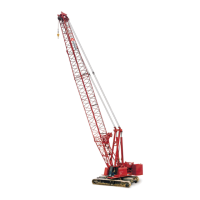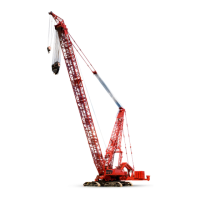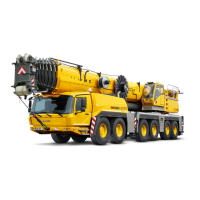Manitowoc Published 10-01-2012, Control # 045-08 1-29
777 SERVICE MANUAL INTRODUCTION
1
BOOM SYSTEM
See Figures 1-18 and 1-19 for following procedures.
If boom pump charge pressure is lost for any reason, boom
load holding solenoid valves HS18 and HS19 shift to block
boom cylinder movement. The boom load holding valves
prevent cylinder movement when not operating or when the
cab power switch is off.
When the cab power switch is placed in the on position, the
PC sends a digital signal to boom load holding solenoid
valve HS19. The solenoid valve shifts to block the tank ports
and supplies pilot pressure from the charge pump to the
boom load holding valves at the piston end of the boom
cylinders. The pilot pressure shifts the boom load holding
valves and opens a path for oil flow to/from the piston end of
the boom cylinders. This path of oil flow from the piston end
of the boom cylinders is open when the cab power switch is
in the on position and the cylinder pressure monitored at the
pressure sender is greater than 600 psi (42 bar). If the
cylinder pressure is less than 600 psi (42 bar), the boom
holding valve opens only with a retract command.
If the pressure monitored at the boom cylinder pressure
sender drops below 600 psi (42 bar) and the boom control
handle is in neutral, the PC shifts the boom load holding
solenoid valve HS19 to move the boom load holding valve to
block boom cylinder movement.
If the boom is raised to the maximum boom stop position
(83° above horizontal while in Standard mode), the boom up
limit switch opens the circuit to the PC. Boom cylinder pump
then strokes to off. The boom load holding valves hold the
boom in position.
The boom cylinders are held in position with boom load
holding valves at each cylinder port. Each boom load holding
valve assembly contains a two position boom load holding
valve and two counterbalance valves. Each counterbalance
valve consist of a check valve section to permit free flow into
cylinder and a pilot operated relief valve section that limits
the pressures inside the cylinder to the preset value(s). The
pilot operated relief valves relieve the rod side of the cylinder
at 5,000 psi (350 bar) and the piston side at 3,000 psi (210
bar). These valves are located on a manifold at the base of
each boom cylinder.
Boom cylinder pump does not stroke in response to boom
handle movement when the boom hoist park switch is on.
It is possible for the boom cylinder to drift over time because
of temperature changes. If cylinder drift occurs, the PC can
send an analog signal to stroke the boom pump to maintain
the boom cylinder position. The boom cylinder pump can
only stroke if the boom cylinder hold switch is in the on
position. The boom control handle must remain in neutral
position.
Twenty percent more oil is required from the boom pump to
extend the boom cylinders (lowering the boom) than there is
oil returning back to the boom pump. Also, there is 20
percent more oil returning to the boom pump inlet from the
cylinder than is pumped to the cylinder when retracting the
cylinders (raising the boom).
The boom hydraulic circuit provides supplemental oil when
lowering the boom and removes excess oil from the circuit
when raising the boom. The accessory pump supplies oil for
boom circuit oil replenishment. When the lower accessory
valve is not being used, a pilot signal from the lower
accessory valve opens a pilot operated check valve,
permitting oil flow from the accessory pump to the hot oil
shuttle valve. The supply of supplemental oil enters the
closed-loop circuit through shuttle valve and check valve
when lowering the boom. The excess oil returns to tank from
the boom cylinder over relief valve when raising or lowering
the boom. The relief valve maintains the closed-loop circuit
pressure at 350 psi (25 bar).
Boom cylinder disable pump solenoid HS24 de-strokes the
boom pump to prevent the boom from moving up or down
without boom handle movement. Two boom cylinder pin
speed senders at the base of boom, monitor boom up or
down movement. If the boom cylinder pin speed senders
detect an up or down movement and the boom control
handle is in neutral, the PC removes power from the boom
cylinder pump disable solenoid HS24 to allow oil in the boom
pump servo valves to equalize, de-stroking the pump.
BOOM HOIST MOTION fault message is shown on the
digital display. To clear the fault, the operator must shut down
the crane, and restart.
When the boom is either raising or lowering, the rotational
signal from the right boom cylinder speed sender is
compared with the rotational signal from the left boom
cylinder speed sender. If the PC determines the boom
cylinders are not extending or retracting together, the display
screen CYLINDER ALIGNMENT message is displayed. The
system red fault light flashes and the fault alert beeper
sounds. The cause should be determined and corrected.
Boom Hoist Rotation Indicator
Whenever the boom raises or lowers, the left boom cylinder
speed sender signal is translated by the PC into a pulse
signal to drive the rotation thumper in the boom control
handle. This pulse signal enables the rotation thumper
pulsation pin to move in a reciprocating motion that indicates
to the operator the boom raising or lowering speed.
Counterweight Handling
When the Setup mode is selected and confirmed, the
counterweight Remote control is enabled. The Remote
control is the master controller and overrides the boom
control handle command, if both controllers are operated at
the same time. Boom operates at a reduced speed when in
the Setup mode.
Boom Off
When the boom control handle is in the off or neutral
position, all commands from the boom control handle to the

